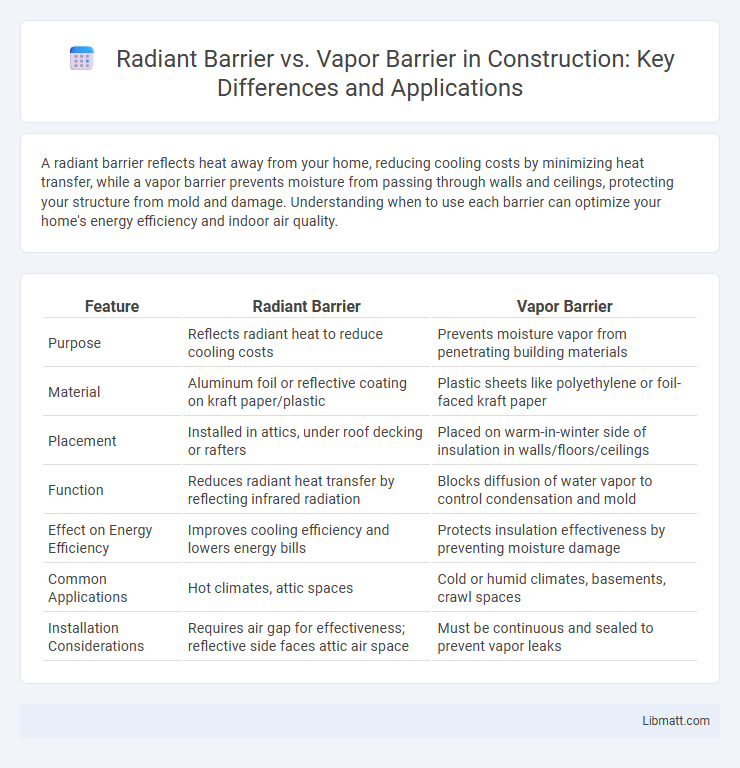A radiant barrier reflects heat away from your home, reducing cooling costs by minimizing heat transfer, while a vapor barrier prevents moisture from passing through walls and ceilings, protecting your structure from mold and damage. Understanding when to use each barrier can optimize your home's energy efficiency and indoor air quality.
Table of Comparison
| Feature | Radiant Barrier | Vapor Barrier |
|---|---|---|
| Purpose | Reflects radiant heat to reduce cooling costs | Prevents moisture vapor from penetrating building materials |
| Material | Aluminum foil or reflective coating on kraft paper/plastic | Plastic sheets like polyethylene or foil-faced kraft paper |
| Placement | Installed in attics, under roof decking or rafters | Placed on warm-in-winter side of insulation in walls/floors/ceilings |
| Function | Reduces radiant heat transfer by reflecting infrared radiation | Blocks diffusion of water vapor to control condensation and mold |
| Effect on Energy Efficiency | Improves cooling efficiency and lowers energy bills | Protects insulation effectiveness by preventing moisture damage |
| Common Applications | Hot climates, attic spaces | Cold or humid climates, basements, crawl spaces |
| Installation Considerations | Requires air gap for effectiveness; reflective side faces attic air space | Must be continuous and sealed to prevent vapor leaks |
Introduction to Radiant and Vapor Barriers
Radiant barriers and vapor barriers serve distinct functions in building insulation, with radiant barriers designed to reflect heat away from living spaces, reducing cooling costs. Vapor barriers control moisture diffusion by blocking water vapor from penetrating walls, floors, or ceilings, preventing mold and structural damage. Effective insulation systems often integrate both types to enhance energy efficiency and maintain indoor air quality.
What is a Radiant Barrier?
A radiant barrier is a reflective insulation material designed to reduce heat transfer by reflecting radiant heat away from living spaces. Typically installed in attics, it consists of a highly reflective surface such as aluminum foil that minimizes heat gain during hot weather, improving energy efficiency. Unlike vapor barriers, radiant barriers do not block moisture but primarily focus on controlling temperature through reflective properties.
What is a Vapor Barrier?
A vapor barrier is a material designed to prevent moisture from passing through walls, floors, and ceilings, effectively reducing the risk of mold and structural damage. Typically made from polyethylene plastic or foil sheets, vapor barriers are installed on the warm side of insulation in a building envelope to control condensation. Unlike radiant barriers that reflect heat, vapor barriers primarily manage moisture movement in building assemblies.
How Do Radiant Barriers Work?
Radiant barriers work by reflecting radiant heat away from living spaces, reducing heat transfer and improving energy efficiency. Installed typically in attics, they consist of a highly reflective material like aluminum foil that blocks the radiant energy from the sun, keeping your home cooler in summer. Unlike vapor barriers that control moisture, radiant barriers specifically target heat reflection to enhance thermal comfort.
How Do Vapor Barriers Function?
Vapor barriers function by preventing moisture from passing through walls, ceilings, and floors, thereby controlling condensation and reducing the risk of mold growth. They are typically made of plastic or foil sheets with low permeability, installed on the warm side of insulation to block water vapor diffusion. Proper placement and continuous sealing ensure vapor barriers effectively maintain indoor air quality and protect building structural integrity.
Key Differences: Radiant Barrier vs Vapor Barrier
Radiant barriers reflect thermal radiation to reduce heat transfer, primarily improving energy efficiency in attics by lowering cooling costs, whereas vapor barriers prevent moisture diffusion to control condensation and protect building structures from mold and rot. Radiant barriers are typically made of reflective materials like aluminum foil, while vapor barriers use plastic or polyethylene sheets to block water vapor movement. The effectiveness of each barrier depends on climate conditions; radiant barriers are most beneficial in hot climates, and vapor barriers are essential in cold or humid environments to maintain indoor air quality and structural integrity.
Benefits of Radiant Barriers
Radiant barriers significantly reduce heat transfer by reflecting radiant energy, resulting in lower cooling costs and enhanced energy efficiency in homes and buildings. These barriers improve indoor comfort by maintaining consistent temperatures and reducing the load on HVAC systems. Unlike vapor barriers, which primarily prevent moisture infiltration, radiant barriers optimize thermal performance by minimizing heat gain during hot seasons.
Advantages of Vapor Barriers
Vapor barriers effectively prevent moisture infiltration, protecting building materials from mold, mildew, and structural damage caused by condensation. They improve indoor air quality by reducing dampness and associated allergens, enhancing overall health and comfort. Vapor barriers also contribute to energy efficiency by maintaining insulation performance and preventing heat loss due to moisture accumulation.
When to Use Each Barrier Type
Radiant barriers are best used in hot climates to reflect heat away from living spaces, improving energy efficiency by reducing cooling costs. Vapor barriers are essential in cold or humid environments to prevent moisture intrusion, protecting your insulation and structural components from mold and decay. Choosing the appropriate barrier depends on your local climate and the specific needs of your building's insulation system.
Choosing the Right Barrier for Your Project
Choosing the right barrier for your project depends on your specific insulation and moisture control needs. Radiant barriers reflect heat and are ideal for reducing cooling costs in hot climates, while vapor barriers prevent moisture from penetrating walls and ceilings, making them essential in humid or cold environments. Evaluate your local climate and building design to determine whether a radiant barrier or vapor barrier will optimize energy efficiency and protect your home effectively.
Radiant barrier vs vapor barrier Infographic

 libmatt.com
libmatt.com